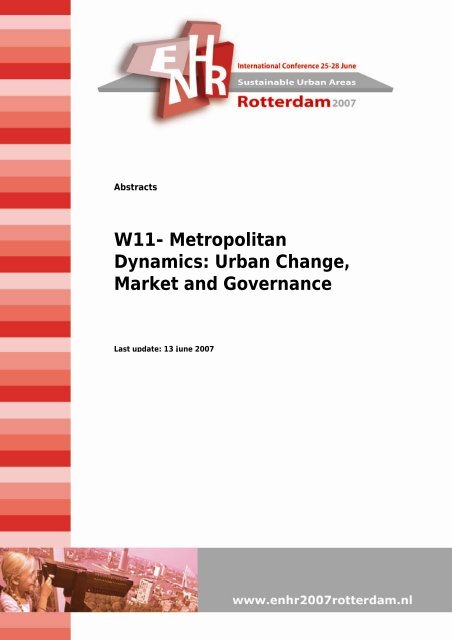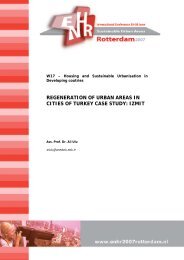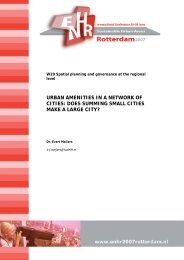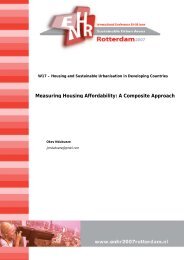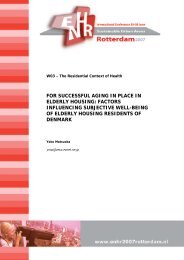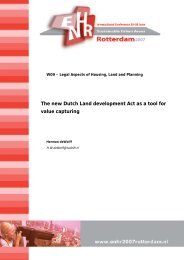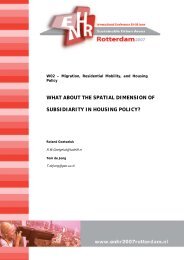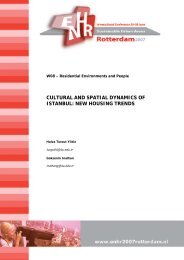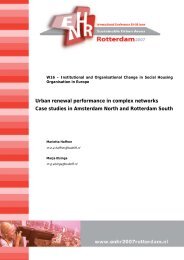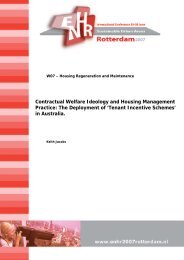Download abstracts - ENHR 2007 Rotterdam
Download abstracts - ENHR 2007 Rotterdam
Download abstracts - ENHR 2007 Rotterdam
Create successful ePaper yourself
Turn your PDF publications into a flip-book with our unique Google optimized e-Paper software.
Abstracts<br />
W11- Metropolitan<br />
Dynamics: Urban Change,<br />
Market and Governance<br />
Last update: 13 june <strong>2007</strong>
Attracting creative knowledge: Strategies towards competitiveness in Amsterdam and<br />
Barcelona<br />
Marco Bontje 1 // M.A.Bontje@uva.nl, Montserrat Pareja Eastaway 2<br />
1 University of Amsterdam, Amsterdam, NETHERLANDS<br />
2 University of Barcelona, Barcelona, SPAIN<br />
Amsterdam and Barcelona recently seem to have become direct competitors in terms of<br />
attractiveness as a business location. In the most recent European Cities Monitor, Barcelona is<br />
4th and Amsterdam 6th in the list of 'best cities to locate a business today'. Amsterdam was far<br />
ahead of Barcelona on that list for years, but Barcelona has meanwhile caught up and even<br />
passed by. Barcelona is often presented as an example of successful urban regeneration,<br />
strategic economic and cultural development planning, and city marketing. Certainly, the<br />
current position of the city in the international landscape is explained as the result of a long<br />
term strategy which already started during the preparation for the Olympic Games candidacy in<br />
the 1980s. Amsterdam's attempts to become more competitive have started much more<br />
recently, partly in reaction to the perceived 'lost ground' to cities like Barcelona. Until last year,<br />
there actually was no such thing as an integral competitiveness strategy. The attempts to make<br />
the city and city-region more competitive rather happened 'piecemeal' in unrelated sectoral<br />
initiatives.<br />
In our paper we want to compare the current and past strategies towards competitiveness of<br />
both cities and their city-regions, with particular attention for the recently increased importance<br />
of attracting creative and knowledge-intensive industries. How much influence has Barcelona's<br />
competitiveness strategy since the 1980s had on the current situation Which positive and<br />
negative effects did it have on the city and the city-region Which other factors contributed to<br />
Barcelona's increased competitiveness And, seen against the Barcelona experience, what<br />
effects can Amsterdam expect from its competitiveness strategy<br />
Gentrification in a globalising world, case study: Istanbul<br />
Nihal Coskun // cos15n@yahoo.com, Burcu Selcen Yalcin<br />
Mimar Sinan Fine Arts University, Istanbul, TURKEY<br />
Today, there is a tendency to regenerate the historical cores of many cities in different<br />
locations of the world. Nevertheless, the efforts of their rehabilitations frequently bring a serious<br />
problem of gentrification of the neighbourhood which result in the changing of the inhabitants<br />
involuntarily.<br />
'Gentrification' in a large scale may surely be regarded as an inevitable fact related with the<br />
capitalist restructuring systems of the world. Many cities located on different territories of the<br />
world with variable economical, political and social characteristics come face to face with this<br />
reality in relationship with how much the city is open to globalising currencies. On the other<br />
hand, gentrification could be considered as a ‘place’ related fact. Although it should be<br />
regarded as an international reality, gentrification of the dilapidated historic neighbourhoods in<br />
different cities of the world may surprisingly show different responds compared to eachother.<br />
In this paper, examples of gentrification period from a metropolitan city, Istanbul will be given to<br />
clarify this diversity in regard with socio-economical and cultural aspects of this fact.<br />
This paper aims to give an overall picture of gentrification movements affected by the local<br />
parameters which are special only for this city; the differences occured in different<br />
neighbourhoods and the innovatives which give a start to this period beginning from 1980’s.<br />
Within this frame, other examples except for the general negative ones which unfortunately<br />
rule this change, others will be studied. In our opinion, these ‘other’ examples rise new hopes<br />
for the future of gentrification in Istanbul by including the inhabitants of the neighbourhoods to<br />
this period that may result in a more sustainable way of life.
(In)formalization and the civilising process: Applying the work of Elias to housing-based<br />
anti-social behaviour interventions in the UK<br />
John Flint 1 // j.f.flint@shu.ac.uk, Ryan Powell 2<br />
1 Sheffield Hallam University, Sheffield, UNITED KINGDOM<br />
2 CRESR, Sheffield Hallam University, Sheffield, UNITED KINGDOM<br />
This paper utilises Norbert Elias' theory of the civilising process to examine trends in social<br />
conduct in the UK and to identify how problematic 'anti-social' behaviour is conceptualised and<br />
governed through housing-based mechanisms of intervention. The paper describes how Elias'<br />
concepts of the formalisation and informalisation of conduct and the construction of insider and<br />
outside groups provides an analytical framework for understanding social relations. It continues<br />
by discussing how de-civilising processes are also evident in contemporary society, and are<br />
applied to current policy discourse around Respect, anti-social behaviour and 'underclass'<br />
theory. The paper utilises the governance of 'anti-social' conduct through housing mechanisms<br />
in the UK to critique the work of Elias and concludes by arguing that a revised concept of the<br />
civilising process provides a useful analytical framework for future studies.<br />
Explaining differentials in housing and neighbourhood satisfaction in post-WWII areas<br />
in Europe<br />
Ronald van Kempen 1 // r.vankempen@geo.uu.nl, Sjoerd de Vos 2 , Sako Musterd 2<br />
1 Utrecht University, Utrecht, NETHERLANDS<br />
2 University of Amsterdam, Amsterdam, NETHERLANDS<br />
In many cities in Europe the estates built in the first decades after the Second World War are<br />
currently under reconstruction. In many of these areas large-scale transformations in the<br />
housing stock have changed the appearance of the estate. Earlier research has indicated that<br />
a large number of inhabitants living in such areas are quite satisfied with their housing situation<br />
and with the neighbourhood itself. Moreover, the high level of satisfaction is definitely not<br />
always the consequence of restructuring processes. It seems that these areas are nice places<br />
to live for all kinds of different groups, elderly and young people, natives and immigrants, large<br />
and small households. But, differentials do exist. In this paper we want to explore the<br />
determinants of housing and neighbourhood satisfaction. Which groups of inhabitants are<br />
particularly satisfied with what And is the level of satisfaction mainly determined by the<br />
individual and household characteristics of the inhabitants, by the characteristics of the<br />
dwelling, or by the characteristics of the neighbourhood It might even be the case that major<br />
differences exist between countries. Answers to these questions might give important clues for<br />
policy makers. If, for example, individual characteristics are more important, a different kind of<br />
policy is needed than in a situation in which aggregate characteristics of the area are<br />
predominant. The paper will be based on a survey held in 29 post-WWII estates in 10<br />
European countries.<br />
About the relationship between housing, income and preferences<br />
Markku Lankinen // markku.lankinen@hel.fi<br />
Urban Facts Helsinki, Helsinki, FINLAND<br />
It is widely known that people’s choice of dwelling type and housing standard is strongly linked<br />
to their assets and disposable income ' and to their expectations as to these factors, which<br />
provide the budgetary framework for housing choice. People’s housing preferences, which are<br />
socially and historically determined, are an important factor, too. Today, the individual housing<br />
choices of part of the population are causing an urban sprawl of detached and terraced<br />
houses, while at the same time the choices of others are contributing to a compact urban<br />
structure. To find out more about this paradox and about the relationship between people’s<br />
preferences and economic potential, a large interview survey was conducted in Finland in the
years 2004 -2005 including a special sample for Helsinki and the Helsinki Metropolitan Area.<br />
While applying this interpretation framework my presentation reports on the crucial findings of<br />
the survey.<br />
Promoting urban fringes and functional re-centralisation as a sustainable spatial<br />
planning strategy for growing cities<br />
Lai-Choo Malone-Lee // rstmalon@nus.edu.sg<br />
National University of Singapore, Singapore, SINGAPORE<br />
Many cities have responded to the problems of urban growth and over-crowdedness in city<br />
centres by promoting decentralization as an urban strategy. Typically, decentralisation implies<br />
a leapfrog approach where new towns with enhanced amenities and employment opportunities<br />
are developed away from central locations, usually on hitherto greenfield, rural or agriculture<br />
lands. The results are often new neighbourhoods in suburban settings that are generally<br />
lacking in character, identity and social cohesion, although there can be exceptions.<br />
The paper examines the experience of the island city state of Singapore in terms of its<br />
experience with the decentralization strategy. Using the case study, it advances the argument<br />
that decentralization, by itself, is an inherently unsustainable approach to accommodate urban<br />
growth, given its attendant costs of greenfield uptake, higher transport infrastructural costs and<br />
sub-optimisation of urban resources. Where city centres are already entrenched in their<br />
economic, social, cultural and political roles, the paper extrapolates that over time, recentralisation<br />
will take its course, with or without government intervention. The attendant<br />
consequences could be unrealistically high price escalations in the real estate market, caused<br />
by a combination of pent-up demand and speculative activities. The paper posits that an<br />
appropriate and more sustainable urban strategy is a gradual centre-to-fringe shift of people<br />
and business in the early stages of urban renewal, as opposed to leapfrogging directly to new<br />
suburban locations. This allows the city to recover, renew and regenerate itself, with least<br />
disruption on social and economic linkages, while preserving urban investments and optimizing<br />
its resources. Fast growing cities may find useful lessons in this mode of development.<br />
Transforming metropolitan Barcelona: Between the postindustrial and the knowledge<br />
city<br />
Carlos Marmolejo Duarte // carlos.marmolejo@upc.edu<br />
Centre of Land Policy and Valuations-UPC, Barcelona, SPAIN<br />
Barcelona has been seen as a European resurgent city, and its urban transformation model<br />
has been several times awarded and imitated. Nevertheless, little research about the<br />
performance of Barcelona’s metropolitan region has been published. In this paper an<br />
exploration of Barcelona’s metro economic and residential dynamics is offered and urban<br />
projects, derived of such processes, are exposed. The research is addressed, first to analyze<br />
the spatial distribution of economic activities and its change across the time, and second to link<br />
such process with the emergence of new projects phenomena and projects. Three structural<br />
transformations characterize the Barcelona’s metro dynamics: a strong tertiarization process, a<br />
progressive ageing of population and a wealthy increase. And two spatial reconfiguration<br />
processes characterize the spatial dynamics: a strong decentralization of residence and a<br />
selective decentralization process of economical activities. As a result of both structural and<br />
spatial changes new urban challenges are faced, like: social exclusion areas derived from<br />
immigration, low density residential projects on the metropolitan periphery, and a strong office<br />
demand at the metropolitan core for intensive-knowledge economic activities.
Planning for sustainable growth in Melbourne (Australia): Housing affordability and<br />
equity implications of constraints on the planning system<br />
Christian Nygaard 1 // c.a.b.nygaard@reading.ac.uk, Elizabeth Taylor 2<br />
1 University of Reading, Reading, UNITED KINGDOM<br />
2 RMIT University, Melbourne, AUSTRALIA<br />
In 2002 the Victorian State Government launched its strategic plan setting the direction for the<br />
city’s growth over the next three decades ' Melbourne 2030. Important aims of the policy are to<br />
create a more compact city, increase the level of affordable housing across the city and ensure<br />
that the benefits of growth are shared fairly. Densification is promoted on grounds of<br />
environmental and urban sustainability. New housing is, however, primarily the reserve of the<br />
private sector and local government authorities do not have the power to require developers to<br />
provide housing at sub-market rents or prices. The government’s primary lever of influencing<br />
housing standards, location and costs are it’s planning and zoning regulations.<br />
In this paper we examine Melbourne 2030’s affordable housing objectives in light of planning<br />
constraints imposed by private sector investment returns and path dependencies generated by<br />
the existing property stock. We use GIS techniques to integrate unit record property<br />
transactions (re-sales) and rental price data and examine the geography of residential<br />
investment returns and asset appreciation; and analyse housing stock path dependency by<br />
including construction year in hedonic housing prices estimation.<br />
We find that the geography of the investment yield components to some extent are inversely<br />
related and differs between property types. Densification and provision of new housing and<br />
apartment type property may thus add to equity/wealth concerns arising from economic<br />
restructuring and household/demographic change by increasing the value of inelastic<br />
neighbourhood externalities. The geography of residential investment returns may also<br />
contribute to persistent and increasing levels of social segregation and wealth inequality and<br />
impede the government’s affordability objectives. House value depreciation may have a U-<br />
shape, making it less likely that older areas will be redeveloped and/or accessible to lower<br />
income households. Policies objectives such as heritage protection may add to this U-shaped<br />
relationship.<br />
Spatial analysis of housing supply and affordability in metropolitan lagos (comparative<br />
analysis of low cost housing estates)<br />
Fatai Ogundele // kunleoguns@yahoo.co.uk<br />
LASU, Ojo, NIGERIA<br />
The study aimed at studying the level of affordability of public housing to the urban dwellers in<br />
Lagos State Housing Estates with the view to highlight the impediments and proffer possible<br />
solutions.<br />
Four public estates were selected as case study.These are Ogba(medium<br />
income),Adekunle(low income) and Amuwo Odofin(low income).<br />
Asimple random sampling was employed to distribute questionnaires to residents in the<br />
selected estates. The questionnaires sought to determine the level of supply vis-a-vis the ever<br />
increasing population of Lagos being the cpommercial nerve centre of the most populated<br />
Africa nation. It was discovered that the supply was grossly inadequate thus forcing up the<br />
prices of housing in obedience to the lawof demand and supply.<br />
Another objective is to determine the purchasing power of the section of the populatin for<br />
whom the houses were meant for. This was done using the present minimum wage in Lagos<br />
state civil service. The findings were very pathetic. It was found out that a fresh graduate will<br />
have to give up to 50% of his total earning . This to a larger extent gave birth to several<br />
shanties and ghettos in and around Lagos environment.<br />
It is also discovered that most of the original allotees have either sold their apartment outrightly<br />
or have let them tothe present occupant. Facilities in these estates were at different state of
dillapidation decause they have been stretched beyond their capacities due to population<br />
explossion.<br />
Conclussively,solutions were proffered to the problems identified and recommenbations made<br />
to those charged with the responsibility of public housing delivery and administration. Also, the<br />
respondents gave useful suggestions on how public housing programme can be implemented<br />
effectively.<br />
High-rise residential development in 'Moscow-City': Case study PLOT 4<br />
Betul Gul Ozyol // betulgulozyol@yahoo.com<br />
ENKA Construction LTD, Moscow, RUSSIAN FEDERATION<br />
MIBC 'Moscow city', is a high-rise development situated within the garden ring of Moscow,<br />
consisting of 3.5 million square meters of office, hotel, retail and recreational areas. The chief<br />
aims of the development are, to introduce sky-scraper architecture to Moscow, to facilitate<br />
creation of quality investment projects, to create large tax bearers and to introduce new quality<br />
workplaces.<br />
The architects and planners from 'Mosproject 2' planned mixed-use buildings so as to keep the<br />
development alive 24 hours. Thus integration of residential units into the majority of buildings<br />
will cultivate urban environment, contribute to the sustainability of social activity. The<br />
residences of MIBC plots are situated in skyscrapers with heights ranging from 230 m to a<br />
soaring 648 m. This is not the first time high-rise living is being introduced to the Moscow real<br />
estate market, however it is the first introduction of high-rise living as part of a mixed-use<br />
scheme.<br />
MIBC development will be supplied by a rapid transport system which will link it to two major<br />
airports, and also by a mini subway line that will connect its three stations to the city subway<br />
network. The office workers and visitors arriving by subway are distributed from ‘Central Core’<br />
to other plots situated on the periphery of Core via pedestrian bridges.<br />
Case study Plot 4 project with a height of 236 m is a mixed-use development comprising of<br />
offices, apartments, hotel and aqua park facilities. Plot 4 residences are situated on the top<br />
section starting from 43rd floor till the top 60th floor promoting living in proximity to major<br />
entertainment, commercial and administrative environments to the emerging elites of Moscow.<br />
MIBC development’s strength relies in mixed-use development scheme as a major urban<br />
regeneration idea. In the place of old botanical gardens of Moscow, now emerges MIBC<br />
development’s first high-rise buildings.<br />
European urban sprawl: Sustainability, cultures of (anti)urbanism and ‘hybrid<br />
cityscapes’<br />
Nataša Pichler-Milanović // natasa.milanovic@guest.arnes.si<br />
University of Ljubljana, Ljubljana, SLOVENIA<br />
This paper has its origins in a comparative research project examining aspects of urban sprawl<br />
in Europe undertaken within the 5.FP EU. The project Urban Sprawl: European Patterns,<br />
Environmental Degradation and Sustainable Development (URBS PANDENS) sought to<br />
understand recent trends in urban sprawl in a number of case study urban regions (Athens,<br />
Liverpool, Leipzig, Ljubljana, Stockholm, Vienna, Warsaw) and to advise the European<br />
Commission on policy development with regard to the control, management and amelioration<br />
of the effects of urban sprawl. The scientific results of the project will be published in the<br />
forthcoming book: Couch, Leontidou, Petchel-Held (Eds.) Urban Sprawl in Europe, Oxford:<br />
Bleckwell, <strong>2007</strong>.<br />
The term »urban sprawl« is often used today rather negatively, typically to describe low<br />
density, inefficient, suburban development around the periphery of cities. Many of the<br />
definitions found in the literature tend to emphasise the idea of urban sprawl being a type of<br />
urban form or a pattern of urbanisation, rather than a process of urban change, - that was a
more useful perspective, since it is the process of »sprawling« that leads to undesirable<br />
development effects, and it is in the process of »sprawling« that policy must intervene.<br />
The aim of URBS PANDENS project was to provide a more general discussion of the nature of<br />
urban sprawl and to consider:<br />
• the extent to which common European patterns and processes of sprawl can be found,<br />
distinct from those previously identified in the USA;<br />
• a small number of important »archetypical« perspectives on European sprawl: life-style<br />
driven, infrastructure-related, state-regulated.<br />
• whether new theories can be formulated to explain urban sprawl;<br />
• what innovations might be suggested regarding the management of urban sprawl.<br />
Behind suburbanisation: New housing construction in Prague Metropolitan Area 1997-<br />
2005<br />
Darina Posova // posova@natur.cuni.cz, Ludek Sykora<br />
Charles University in Prague, Praha 2, CZECH REPUBLIC<br />
Numerous recent articles about urban change in post-socialist cities present suburbanisation<br />
as the main process that reshapes the geography of metropolitan areas in Central and Eastern<br />
Europe. Our paper does not question these findings. However, on the example of Prague it<br />
brings an additional dimension that helps to clarify the significance of suburbanisation process<br />
in the context of overall urban change. We focus on residential suburbanisation and use data<br />
about new housing construction in 1997-2005, i.e. since the beginning of more massive<br />
suburbanisation. Our findings show that despite suburban areas account for large share of<br />
newly constructed housing, majority is build within compact city. In suburban areas, new<br />
housing construction brings radical change of places where it concentrates. On the other hand<br />
side, even larger amount of new dwellings constructed in already established inner city<br />
neighbourhoods does not bring such a relative growth like in suburban belt. However, large<br />
share of new housing construction in central cities shows their vitality and strength of<br />
alternatives to suburbanisation. In addition the paper illustrates the strengthening position of<br />
Prague metropolitan area within the country and changing profiles of new housing construction<br />
in relation to the distance from the city centre, including size and price of dwellings. The main<br />
message, however, which we want to deliver and empirically document is that suburbanisation<br />
is not the single major process that reshapes post-communist Prague. There are alternatives<br />
that have to be considered in interpreting urban change in Central and Eastern Europe,<br />
alternatives that show the vitality of urban cores and offer more sustainable alternatives to<br />
sprawling post-communist metropolis.<br />
Crossing continents, changing places: The neighbourhood consequences of new<br />
immigration<br />
David Robinson // d.robinson@shu.ac.uk<br />
Sheffield Hallam University, Sheffield, UNITED KINGDOM<br />
Much is being said about new immigration in the UK, but little is actually known about the daily<br />
realities of new immigration or the factors shaping these experiences. Much is also being made<br />
about the contribution of new immigration to the supposed crisis of cohesion in urban society,<br />
but little is known about the neighbourhood consequences of new immigration. Research and<br />
analysis of new immigration has tended to focus on broad policy concerns (such as the<br />
operation of the asylum system), wider impacts of new immigration (such as the consequences<br />
for the national economy) or the particular experiences of new immigrants (such as the<br />
incidence and experiences of homelessness). Analysis has largely failed to situate the<br />
experiences of new immigrants in the particular places that they reside and to consider if and<br />
how these experiences vary between different places, or to recognise and explore the<br />
transforming effect of new immigration at the local level. This paper proposes a conceptual
framework designed to support efforts to address this significant caveat in knowledge and<br />
understanding. A threefold classification is presented that integrates attention to the<br />
consequences of new immigration for individuals, communities and neighbourhoods, while<br />
recognising the importance of contingent factors, including the nature of place, issues of<br />
identity and the significance of individual and collective agency. The result is an approach that<br />
recognises the inter-relationships between the housing and related opportunities and<br />
experiences of new immigrants and 'receiving' populations, community relations and<br />
neighbourhood sustainability.<br />
The concept of sustainable urban development. The case of greater Jakarta<br />
Jo Santoso // josantosojkt@yahoo.com<br />
Tarumanagara University Jakarta, Jakarta, INDONESIA<br />
A massive urban sprawl in “Greater Jakarta” has been escalated during the last 2 (two)<br />
decades. A large number of new towns, real estates, and industrial settlements emerged in<br />
this 2000 sq km region called “Jabodetabek” (Jakarta-Bogor-Depok-Tangerang-Bekasi). In<br />
between, the inner city of Jakarta has change in very high acceleration. It is predictable, that<br />
the deterioration of the infrastructure and the declining of the livability will go forward. Hence,<br />
it is important to address strategic planning approaches to anticipate the rapid development<br />
of the Jakarta Metropolitan in the future. There are numbers of recommendation already<br />
exist, the paper has the intention to calculate malleability of some new concepts, i.e.,<br />
”sustainable development” and “multistakeholder planning approach”, which are currently<br />
worldwide favorites by the academic and policy maker circles.<br />
The author underlines the need to reform the “liberal,” growth oriented urban policy from the<br />
past. The new policy should be focus on the improvement of the livability and the<br />
competitiveness of the city as absolute priorities.<br />
The city government should have a strong political will to execute necessary political<br />
fundamental changes to establish sustainable urban policy base on multi-stakeholder<br />
planning approach. A new system of urban management should be developed by taking into<br />
consideration the multiple conflicting situations between 4 different groups of stakeholder;<br />
the first (the inhabitant) needs Jakarta as daily service center, the second as a regionalmetropolitant<br />
center, the third as national center for governmental and economic institutions<br />
and the last group as sub-system of global economic network. The priority program of the<br />
new management should focus its efforts to control the process of unbalanced and unethical<br />
land-use generated through unfair distribution of strategic important resources like land,<br />
water and others included social capital.<br />
City-regions in Europe: The potentials and the realities<br />
Iván Tosics // tosics@mri.hu<br />
Metropolitan Research Institute, Budapest, HUNGARY<br />
The aim of the paper is to analyse the recently very fashionable ‘city-region’ (metropolitan<br />
area) issue. Two very different sources of information will be taken into account for the same<br />
group of cities. One of these is a very fresh ESPON analysis on urban functions for all EU<br />
metropolitan areas, which differentiates between morphological and functional urban areas.<br />
The other is a recent URBACT project, which focuses on exploring administrative set-ups and<br />
territorial policies within eight European metropolitan areas (Birmingham, Budapest, Cologne,<br />
Frankfurt, Glasgow, Lille, Malmö, Milan). The combination of these two empirical sources<br />
allows the comparison between geographic-economic ‘realities’ and administratively-politically<br />
dominated ‘actions’ for the eight case study urban areas.<br />
On this empirical basis it is interesting to explore the large differences between EU countries<br />
and regions towards city-region cooperation. Dominated one the one hand by local conflicts
etween settlements of the same area and on the other hand by the challenge for international<br />
competition between metropolitan areas, there are substantially different cases observable,<br />
how metropolitan-wide policies are built up (top-down or bottom-up) in relation of planning,<br />
economic and regulatory functions. From the analysis it becomes clear that in the European<br />
context the boundaries of national states and administrative-political regions (and settlements)<br />
constitute very strong barriers against policies which would aim to optimize the position of the<br />
metropolitan areas.<br />
A tool to measure opportunities and risks of converting empty offices into dwellings<br />
Theo J.M. van der Voordt // D.J.M.vanderVoordt@tudelft.nl, Rob Geraedts<br />
Delft University of Technology, Delft, NETHERLANDS<br />
In the Netherlands, both the office market and housing market show a mismatch between<br />
supply and demand, quantitatively and qualitatively. In <strong>2007</strong> 14% of all offices are vacant, i.e.<br />
5.9 million square meters. Experts judge at least 1 million m2 as having no chance to be let<br />
again as an office. At the same time we see a shortage of about 1 million dwellings. This paper<br />
discusses opportunities and risks of converting empty offices into houses. A checklist will be<br />
presented to support the decision whether or not starting a transformation process and a<br />
number of go/no go decisions later on. This checklist is partly based on a literature survey on<br />
user requirements and preferences with respect to office accommodation and housing, and<br />
partly on interviews with parties involved in transformation processes in the Netherlands. The<br />
interviewees were asked which features of locations and buildings they considered to be most<br />
relevant. An earlier draft of the checklist has been tested in practice by market players and<br />
students of architecture. The five steps method - from quick and dirty to a more thorough study<br />
- include an analysis of the local market and critical characteristics of the location and the<br />
building(s), an economic feasibility study and a check on a number of risk factors from a<br />
functional, architectonical, juridical and technical point of view from different stakeholders.<br />
Using veto criteria and gradual criteria the method shows which features of the location and the<br />
building favour successful transformation, and which hinder it. A number of examples of<br />
converted office buildings for different target groups will be presented to demonstrate the use<br />
of the checklist and to show how conversion of empty buildings can submit to rehabilitation and<br />
upgrading of urban areas.<br />
A public choice perspective on Chinese urban housing markets: Theory and cases<br />
Richard Walker 1 // rwalker@hku.hk, Lianje Ma 2<br />
1 University of Hong Kong, Hong kong, HONG KONG<br />
2 Huazhong University of Science and Technology, Wuhan, CHINA<br />
Chinese urban housing markets have been transformed over the last three decades. They<br />
have moved from a system typified by bureaucratic hierarchy to one dominated by the market<br />
processes and mechanisms. This remarkable transformation in the governance of one policy<br />
domain raises a number of important research questions: What factors drove reform and what<br />
theories might explain these reforms. What was the process of reform and have the types of<br />
output anticipated been achieved What is impact of these reforms Have they increased<br />
efficiency, responsiveness and equity<br />
This paper will explain the reform programme in Chinese urban housing markets from a public<br />
choice theory perspective. Public choice theory argues that efficiency and responsesiveness<br />
will be increased if competition is brought into public organizations, information on public<br />
organizations and policy arenas made public and the size of organizations reduced (Niskannen<br />
1971). Evidence from elsewhere in the world suggests that public choice theory inspired<br />
reforms may result in anticipated outcomes: the consequences for efficiency and<br />
responsiveness are not always clear, while the findings for equity are negative (Boyne and<br />
Walker 1999; Walker and Li 2006).
The paper will firstly review housing policy reform in China and examine the extent to which it<br />
conforms to public choice theory principles. Second, we will review the growing literature on<br />
Chinese urban housing markets to examine the extent to which it has been used to explain<br />
reform. Third case study evidence on the nature and impact of reform will be presented from<br />
Wuhan. The case study material will examine how reform in different parts of the housing<br />
market relates to public choice principles and include an examination of the consequences of<br />
these reforms. The case material will also examine the implications of these reforms for the<br />
provision of public services associated with housing provision.<br />
Vigorous economic heart: Recent trends of continuous concentration and development<br />
of Hong Kong's Central Business District<br />
Sancia Wai-San Wan // sancia_sancia@yahoo.com<br />
The University of Hong Kong, Hong kong, HONG KONG<br />
In spite of frequent debates for decentralisation of economic activities from the city centre, or<br />
commonly known as the central business district (CBD), concentration of higher-order service<br />
functions remains and is even intensified in many fast-growing cities of the Asia-Pacific region.<br />
Already developed as a commercial heart for decades, the CBD of Hong Kong has enjoyed<br />
continuous growth especially benefited from the city's transition to a service economy since the<br />
late 1970s.<br />
This paper attempts to uncover the development trends of this robust economic centre since<br />
the 1990s, when the service industry has nourished to a mature level. The author adopts<br />
employment and land use data of the past decade to reveal the spatial distribution pattern and<br />
historical changes of economic activities in the CBD compared with other parts of the territory.<br />
The paper finds that this city core has been growing laterally and vertically in terms of<br />
territorial-spatial extent, as well as purifying as an advanced service centre. Such economic<br />
activities as finance, banking and stock and exchange have been increasingly predominant in<br />
the CBD, thus raising the demand for high-quality offices. A uniquely conspicuous but compact<br />
built form, characterized by modern commercial skyscrapers, is resulted. The physical and<br />
functional dynamism of the CBD therefore not only deserves policy makers' attention to take<br />
this advantage to sustain further growth of the city's economy, but also draws our concerns<br />
about how the future cityscape will be created.


